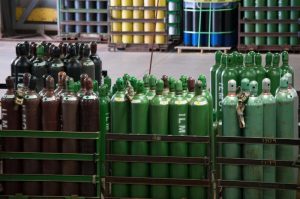Gas Cylinder Safety Tips for Welders
Posted on: May 30, 2018

There are many signs of wear and damage on a cylinder that could be a safety issue. Look for cracks, dents, leaks, bulges, corrosion, or rust that could show a tank is either leaking or on the verge of leaking.
Check the values and other safety devices for wear or signs of being defective. In addition, more extreme issues such as heat or fire damage from a particular job should throw up a red flag. If you suspect a tank is defective, consult your local dealer to ensure it is properly taken care of before getting to work.
On the other hand, aluminum cylinders make up for their higher cost by being lighter to handle and more resistant to rust and corrosion when compared to steel. If you’re working with wet gases or in a humid environment, aluminum can be a real plus for welders.
Cylinders are often tested once every five years, although some tanks can be marked by inspectors for inspection every ten years. A Five-pointed star typically indicates whether or not a cylinder can be tested every ten years.
A hydrostatic test measures how a gas cylinder performs under pressure by applying five-thirds the operating pressure to the cylinder in question, unless otherwise specified by the manufacturer. For instance, a 4,500-pound-per-square-inch (psi) cylinder would be tested at 7,500 pounds psi. The water jacket method of testing encloses the cylinder in a high-pressure jacket enclosure.
When the gas in a cylinder isn’t oxygen, such as liquefied petroleum gas, the testing procedures will be different and may only be required 7-12 years, depending on the state of the tank.
Gas cylinders typically have markings that are vertically or horizontally aligned and that offer critical information about the cylinder, how to fill it, when it was last inspected, and when it should be inspected again. Oxygen cylinders are usually green and have information stamped toward the top. According to an example from the U.S. Army, the markings can be read in the following way:
- DOT = Department of Transportation
- 3AA = Seamless alloy-steel cylinder
- 2015 = 2015 psig fill pressure
- 1234567 = Serial number of cylinder
- XY Corp = Manufacture of cylinder
- 8 ® 08 = Month and Year, in this example, August 2008, the symbol of the inspector is commonly placed between month and year (® used as an example only)
- + = Cylinder maximum fill pressure can be 10% above 2015 psig or 2216.5 psig
- ۞ = Cylinder may be tested every 10 years versus the standard 5 years
Keep in mind that a cylinder past its hydrostatic test date can still be used, whether it is full or partially full. Experts recommend using the gas cylinder until it is empty and then having it retested before filling it again.
